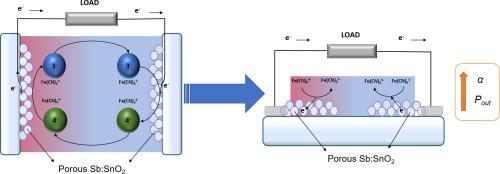当前位置:
X-MOL 学术
›
Electrochem. Commun.
›
论文详情
Our official English website, www.x-mol.net, welcomes your feedback! (Note: you will need to create a separate account there.)
Evaluation of in-plane architecture in a thermo-electrochemical cell with nanostructured and porous Sb:SnO2 electrodes
Electrochemistry Communications ( IF 4.7 ) Pub Date : 2024-05-11 , DOI: 10.1016/j.elecom.2024.107750 S. Castro-Ruiz , J. García-Cañadas
Electrochemistry Communications ( IF 4.7 ) Pub Date : 2024-05-11 , DOI: 10.1016/j.elecom.2024.107750 S. Castro-Ruiz , J. García-Cañadas

|
Thermo-electrochemical cells (TECs) are able to convert heat into electricity. They are formed by two electrodes (typically Pt) separated by a redox electrolyte (usually 0.4 M aqueous ferro/ferricyanide). The widely adopted architecture of TECs consists of the two electrodes separated by an electrolyte channel. To our knowledge, no studies have been reported exploring a different architecture. Here, we evaluate an alternative configuration, which comprises a substrate with the two electrodes at its ends and with the electrolyte added on the top contacting both electrodes, forming a planar configuration. We explore first the use of the standard Pt electrodes deposited on top of a conductive glass substrate. Then, we replace the Pt by nanostructured and porous Sb-doped SnO. The planar configurations are compared with their corresponding typical architectures using the common ferro/ferricyanide electrolyte. It was found that the planar TEC with Sb:SnO reached a temperature coefficient of 1.76 mV/K, higher than the value obtained in the standard configuration with Sb:SnO (1.21 mV/K), and also higher than the planar architecture with Pt electrodes, which showed the typical value for the ferro/ferricyanide electrolyte (1.45 mV/K). As a consequence of this significantly larger value, a 29.7 % higher maximum power output than the planar TEC with Pt was observed. Our study identifies for the first time interesting new features when a planar architecture is employed, opening the door to explore in more detail this alternative configuration in TECs.
中文翻译:

使用纳米结构和多孔 Sb:SnO2 电极的热电化学电池的面内结构评估
热电化学电池 (TEC) 能够将热量转化为电能。它们由两个电极(通常为 Pt)组成,并由氧化还原电解质(通常为 0.4 M 铁/铁氰化物水溶液)分隔开。广泛采用的 TEC 架构由由电解质通道分隔的两个电极组成。据我们所知,还没有研究报告探索不同的架构。在这里,我们评估了一种替代配置,该配置包括一个基板,其两端有两个电极,并且在顶部添加了与两个电极接触的电解质,形成平面配置。我们首先探索沉积在导电玻璃基板顶部的标准铂电极的使用。然后,我们用纳米结构和多孔掺锑 SnO 代替 Pt。将平面结构与使用常见的铁/铁氰化物电解质的相应典型结构进行比较。结果发现,Sb:SnO 平面 TEC 的温度系数达到 1.76 mV/K,高于 Sb:SnO 标准配置中获得的值 (1.21 mV/K),也高于 Pt 平面结构电极,显示铁/铁氰化物电解质的典型值 (1.45 mV/K)。由于该值显着增大,最大功率输出比含 Pt 的平面 TEC 高 29.7%。我们的研究首次确定了采用平面架构时有趣的新特征,为更详细地探索 TEC 中的这种替代配置打开了大门。
更新日期:2024-05-11
中文翻译:

使用纳米结构和多孔 Sb:SnO2 电极的热电化学电池的面内结构评估
热电化学电池 (TEC) 能够将热量转化为电能。它们由两个电极(通常为 Pt)组成,并由氧化还原电解质(通常为 0.4 M 铁/铁氰化物水溶液)分隔开。广泛采用的 TEC 架构由由电解质通道分隔的两个电极组成。据我们所知,还没有研究报告探索不同的架构。在这里,我们评估了一种替代配置,该配置包括一个基板,其两端有两个电极,并且在顶部添加了与两个电极接触的电解质,形成平面配置。我们首先探索沉积在导电玻璃基板顶部的标准铂电极的使用。然后,我们用纳米结构和多孔掺锑 SnO 代替 Pt。将平面结构与使用常见的铁/铁氰化物电解质的相应典型结构进行比较。结果发现,Sb:SnO 平面 TEC 的温度系数达到 1.76 mV/K,高于 Sb:SnO 标准配置中获得的值 (1.21 mV/K),也高于 Pt 平面结构电极,显示铁/铁氰化物电解质的典型值 (1.45 mV/K)。由于该值显着增大,最大功率输出比含 Pt 的平面 TEC 高 29.7%。我们的研究首次确定了采用平面架构时有趣的新特征,为更详细地探索 TEC 中的这种替代配置打开了大门。
















































 京公网安备 11010802027423号
京公网安备 11010802027423号